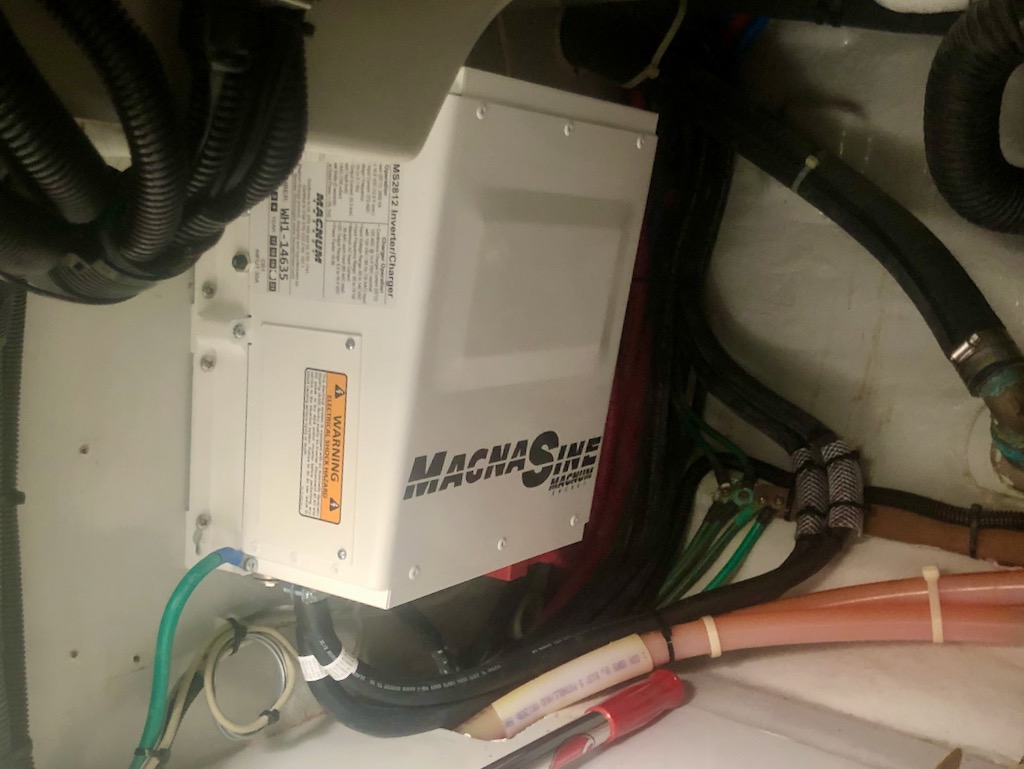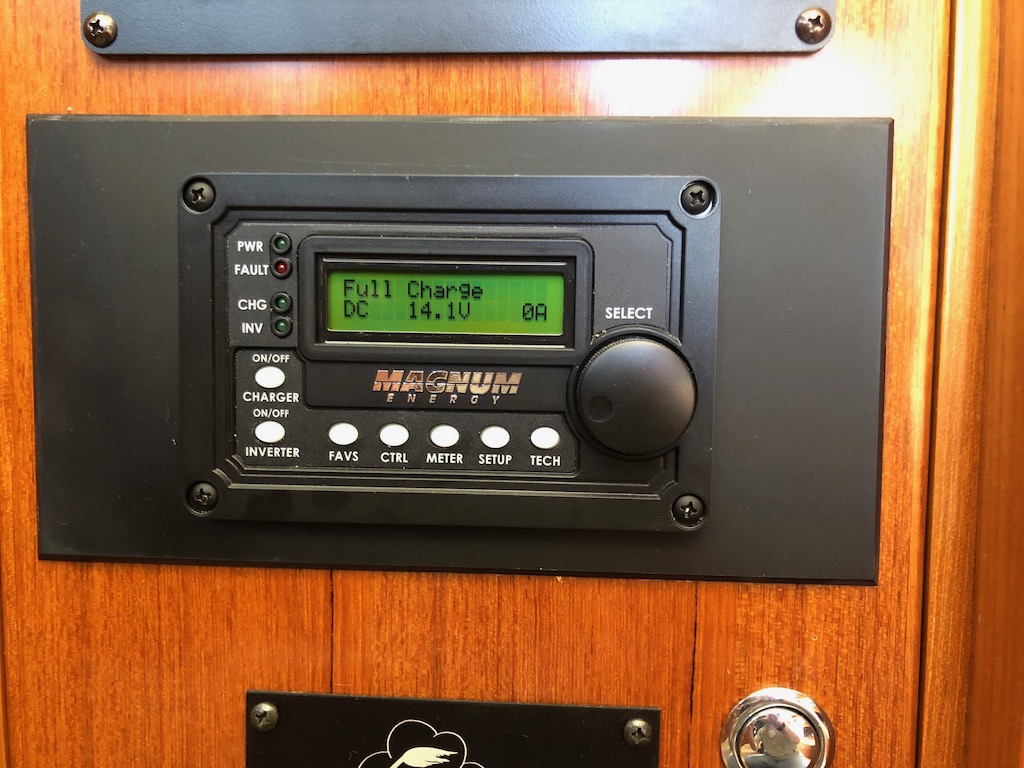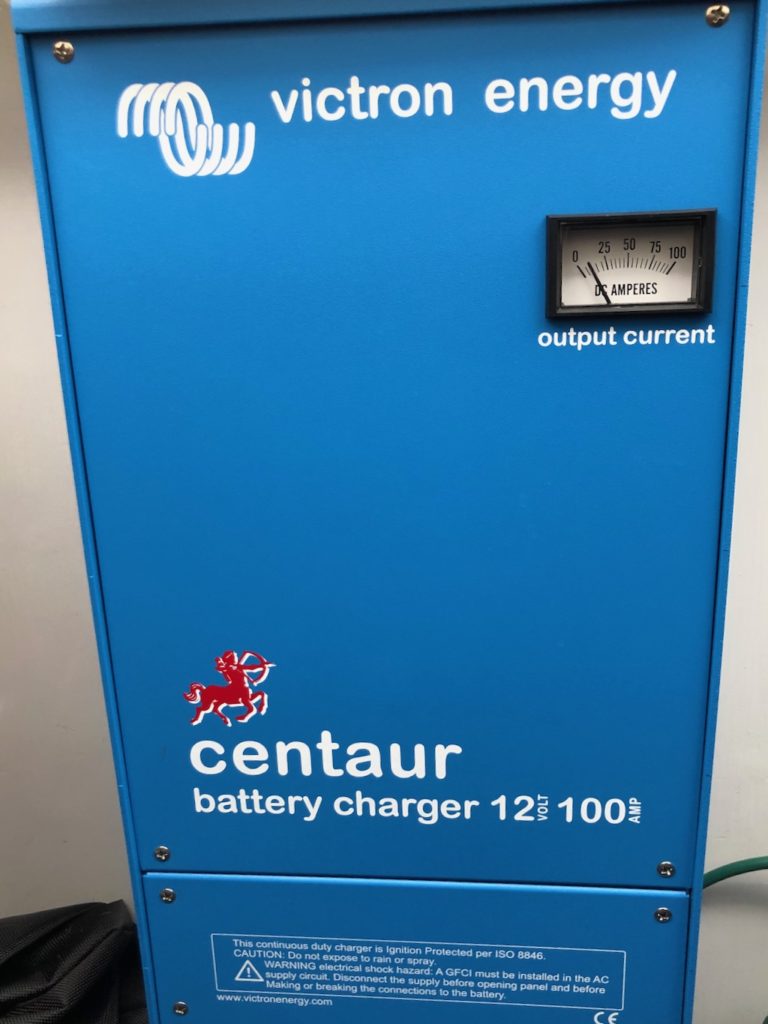During our two decades of sailing, we held a particular disdain for powerboats and their noisy generators. On starlit nights, the chug-chug-chug of neighboring generators disturbed the quiet stillness of the anchorage. Back then, we could be smug. With the simple systems on a sailboat, we could go days and days on the hook, relying only on the small house battery bank for power.
Times have certainly changed for this old sailor.
On Indiscretion, we operate lots of power-hungry systems. Three refrigeration systems provide ample food storage for expeditions spanning a month or more between provisioning. A watermaker, extensive interior lighting, computerized vessel monitoring, TVs and entertainment systems, electric toilets, etc. etc. all take their toll on our bank of house batteries.
At anchor, we typically run our generator for two hours in the morning and two hours at night to keep the batteries reasonably well charged. We take our cue from a computer display that provides a state of charge reading for our four Lifeline 8D house batteries. We start the generator when the state of charge drops to 50% and run it until we reach an absorption charge state of 75%. Morning and night.
While I love all the fantastic systems and equipment aboard our trawler, I find I’ve become a bit obsessive with tracking and eliminating any excess power draws to avoid draining our house bank unnecessarily. The ship’s panel shows our battery voltage (a proxy for our state of charge) and amps currently being drawn. When one of the refrigeration systems cycles on, this amp reading jumps way up. If I’m in the pilothouse and happen to glance down at the amp meter during one of these times, my pulse quickens. “What’s drawing all this power?” I ask myself, looking around for something left on. I have a habit of touring the boat at various points, making sure lights are off. At anchor, I am an electricity miser.
Unlike many other powerboats we’ve encountered, the sound-enclosure of our Northern Lights generator, buried deep inside a well-insulated engine room, keeps the noise to a minimum. Other than a burbling from the wet exhaust, it’s hard to tell it’s even running from outside the boat. That makes me feel a little better when I crank up the engine inside a quiet anchorage.
Early in our trawler ownership, I asked the owner of a prominent yacht service company here in Seattle about installing solar panels on Indiscretion’s fixed flybridge cover. Harnessing the power of the sun seemed like a great idea to cut down on generator time.
“You sailors just don’t get it,” he grumbled. “These expedition trawlers require a tremendous amount of electricity to operate. It’s not like the simple systems of a sailboat. Solar panels wouldn’t make any meaningful difference at all in your case. Don’t waste your money.”
During last summer’s cruising, we needed to run the generator even longer, the more days we were away from shore power. We kept track of our daily generator runtimes to assess battery performance. The logs showed that after four days at anchor, we ran the generator close to eight hours a day to keep up. This normally wouldn’t be a huge issue since we have plenty of fuel aboard to run the generator, but Indiscretion was commissioned with an oversized 12KW generator that needs to be run with at least a 50% electrical load to avoid maintenance issues down the road. Running the generator just to charge batteries might work with a smaller generator, but it’s a no-no with this big engine.
When a fuse blew on our ten-year-old Xantrex inverter during an overnight cruise, we learned we had a critical dependency on this aging device. Without an inverter, many of our systems, including our refrigeration, would fail to operate unless we ran the generator or plugged into shore power. After reading up other trawler captains’ experience with our inverter model, we discovered that its useful life runs about ten years. We were on borrowed time. If our inverter failed on a long trip, we would be in a pickle.
Once home from our summer cruising, we took all this information to Mickey Smith, a marine electrical guru at Pacific Yacht Management here in Seattle. Mickey is a living legend in the Nordhavn trawler community. He knows more about the electrical makeup of these vessels than maybe anyone alive. When he visited us on board to go over our battery charging needs, he pointed out his signature on the original as-built electrical diagrams for Indiscretion we keep as reference below the pilothouse settee. We knew right away we were in good hands.
Based on Mickey’s advice, we decided an overhaul of our battery charging system was necessary. We replaced all seven of our five-year-old Lifeline AGM batteries. And even though it was still functional, we preemptively replaced our Xantrex inverter with a new Magnum MS2812 2800W inverter/charger. The Magnum control panel in the pilothouse fit beautifully where the old Xantrex one used to be. And to speed battery charging and load on our generator, we added a second battery charger — a Victron Centaur — designed to charge in parallel with the Magnum. We also reconfigured our Maretron DCM100 battery monitoring system to provide a more accurate state of charge percentage for our battery bank. With brute strength and tenacity, we replaced all the batteries ourselves, but we hired Mickey to replace the inverter and add the second charger. All told, we spent about $15,000 on the project.



We had a chance to test our new charging setup last month during our empty nest cruise through the San Juan Islands. While we still needed to run the generator morning and night, our generator runtimes stayed under two hours per session, no matter how long we stayed away from shore power. As we had hoped, the Victron charger added a hefty load on the generator during the initial bulk charging phase. We no longer needed to scurry around, turning on various appliances and systems when we charged the batteries.
When using the generator to charge our batteries, we rarely exceed a 75% state of charge. Our house battery bank needs to be charged to 100% at least once a week to avoid shortening its life span. We did plug into shore power weekly on our trip and discovered that the main engine’s alternator can top off the batteries on a longer motoring passage.
I am pleased with the upgrades we made to Indiscretion’s charging system. I have grudgingly accepted the need to run the generator morning and night, and we can travel now for an extended period without running without needing to return to port for shore power.
I am still thinking about installing solar panels on the roof of our flybridge. We met a couple of trawler skippers on last month’s cruise that swore by them, saying they cut their generator time in half. I’ve read accounts of other Nordhavn owners who have experienced similar results. And when these our AGM batteries reach their end of life, lighter and faster-charging lithium batteries will almost certainly take their place. Between solar panels and more efficient batteries, we might someday reach a point where this former sailor can finally relax and enjoy the stillness of a quiet anchorage and the wonderful electrical amenities this trawler affords.
I can dream, can’t I?



What an amazing blog! Thank you for documenting your journey in such beautiful detail. My husband and I are aspiring future trawler owners. We’re preparing for a week long training course through the San Juan’s on a Nordic Tug. Coming for a 22 foot Larson deck boat…we have a seemingly unattainable amount to learn. Your blog has been inspiring, educational, and engaging. Perhaps while you’re out on these voyages you might take up a pen to write a novel? You’re a talented writer! Gifted.
One quick question- how often are you heating your interior? I would think this would be difficult while at anchor, but perhaps with your setup you’ve allowed yourself these comforts? I would imagine your spring and fall sailings would be less than ideal without nice warm cabin, head, saloon and galley. I’m curious how you navigate this challenge during the day and at night. Thank you again for this amazing and inspirational resource you’ve created! I’ll be following!! Happy trawling!!